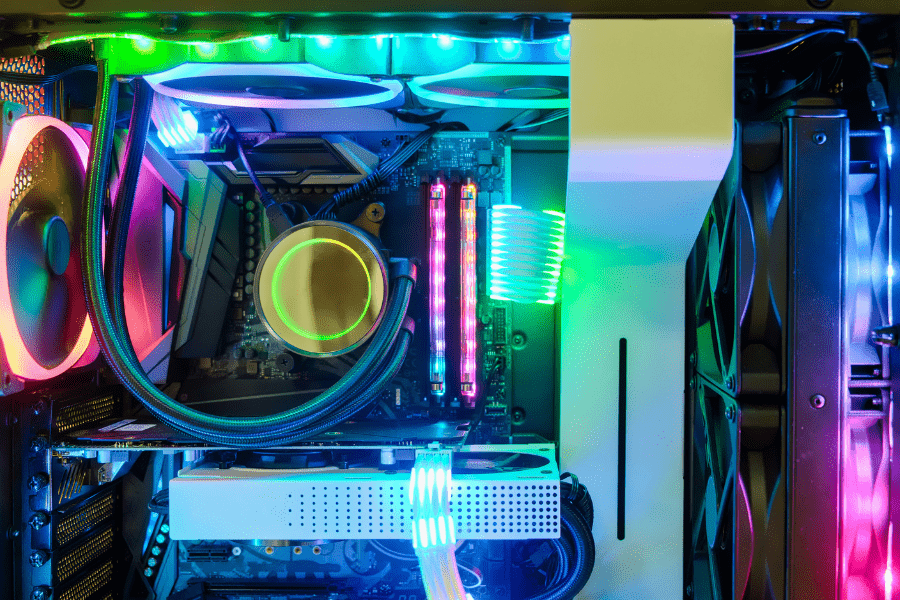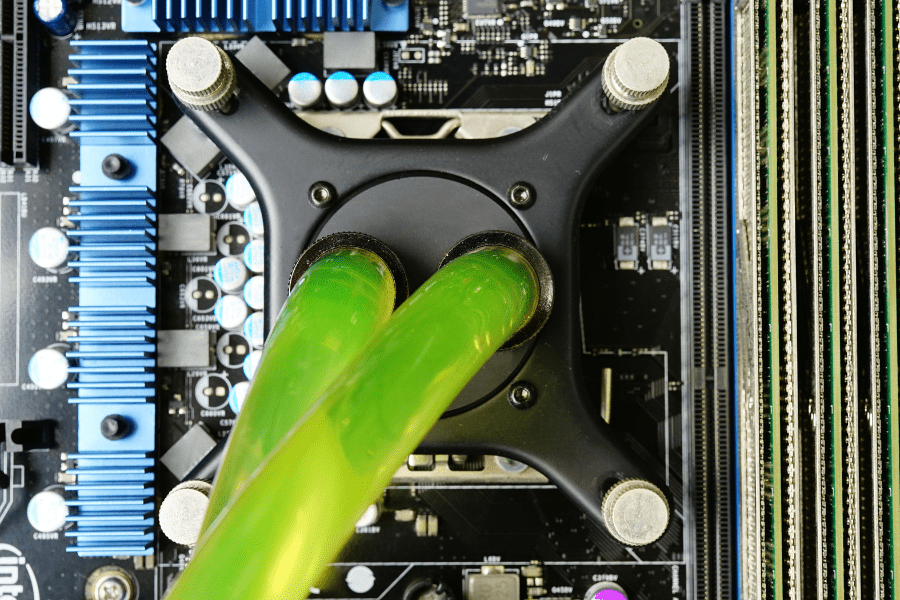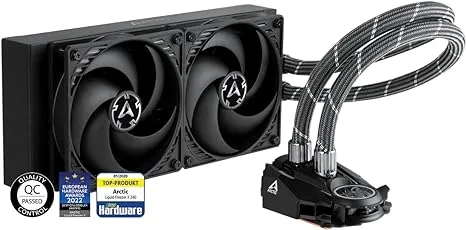Table of Contents
Water Cooled CPU Systems Explained

Water cooling represents a more advanced approach to CPU cooling, often favored in high-performance and gaming PCs. This method uses water, an efficient heat conductor, to manage CPU temperatures. Let’s delve into the world of Water Cooled CPU systems and understand how they work.
What are Water Cooled CPU Systems?
Water Cooled CPU systems, also known as liquid cooling systems, use a water-based coolant to transfer heat away from the CPU. Unlike air coolers that dissipate heat via air, water cooling uses the superior thermal conductivity of liquid to effectively manage high temperatures.
Components of a Water Cooling System
A typical water cooling setup includes the following components:
- Water Block: This is the part that directly contacts the CPU, absorbing heat. It replaces the traditional heatsink found in air coolers.
- Radiator: The heated coolant is transferred to a radiator, where it releases heat into the air. Radiators come in various sizes and are usually mounted on the case’s external vents.
- Pump: The pump circulates the coolant through the system, ensuring continuous heat transfer from the CPU to the radiator.
- Coolant Reservoir: Some systems include a reservoir that holds extra coolant, making it easier to manage and top-up the liquid.
- Tubing: Durable tubes connect these components, forming a closed-loop through which the coolant flows.
How Water Cooling Works
The process of water cooling is a cycle of heat absorption and dissipation:
- Heat Absorption: The water block absorbs heat from the CPU, transferring it to the coolant.
- Heat Transfer: The heated coolant is pumped away from the CPU to the radiator.
- Cooling and Circulation: At the radiator, heat is released into the air, and the cooled liquid is circulated back to the water block.
Advantages of Water Cooling
- Efficient Cooling: Water cooling can handle much higher heat loads, making it ideal for overclocking or high-performance tasks.
- Quieter Operation: Generally, water cooling systems produce less noise compared to air cooling, as they don’t rely on large fans.
- Aesthetic Appeal: Many water cooling setups are visually impressive, with clear tubes, colored coolants, and LED lighting, enhancing the aesthetics of a PC build.
Challenges of Water Cooling
- Complexity and Cost: Water cooling systems are typically more complex and expensive than air coolers.
- Installation and Maintenance: They require a more intricate setup and regular maintenance, including monitoring liquid levels and potential leak checks.
- Space Requirements: Depending on the size of the radiator and reservoir, water cooling systems can require significant space inside or outside the PC case.
Advantages and Challenges of Water Cooled CPUs

Water Cooled CPU systems have gained popularity, especially among PC enthusiasts and in high-performance computing. While they offer several benefits over traditional air cooling, there are also specific challenges to consider. Understanding these can help in deciding whether a water cooling setup is right for you.
Advantages of Water Cooled CPUs
- Superior Cooling Performance: Water has a higher thermal conductivity than air, making water cooling systems more efficient in heat dissipation. This is particularly beneficial for overclocked CPUs or high-load computing tasks, where heat generation is significantly higher.
- Quieter Operation: Generally, water cooled systems produce less noise. The primary sound in such systems is often just the hum of the pump, which is usually quieter than the whir of multiple fans in air cooling setups.
- Aesthetics and Customization: Water cooling can add a visually striking element to PC builds. With customizable components like colored coolants, transparent tubes, and LED lighting, water cooling setups can be tailored to enhance the aesthetic appeal of a PC.
- Reduced Hotspots: Water cooling can more evenly distribute heat away from the CPU and other hot components, reducing the risk of hotspots which can be a concern in air-cooled systems.
- Longer Lifespan of Components: By maintaining lower temperatures, water cooling can potentially prolong the lifespan of the CPU and other components that are sensitive to heat.
Challenges of Water Cooled CPUs
- Higher Cost: Water cooling systems are generally more expensive than air coolers. This includes not just the initial cost of the components but also potential maintenance costs over time.
- Complex Installation and Maintenance: Setting up a water cooling system can be complex, often requiring more time and technical knowledge than installing an air cooler. Maintenance tasks like checking for leaks and refilling the coolant add to the upkeep efforts.
- Risk of Leaks: Although rare with proper installation and maintenance, there is always a risk of leaks with water cooling systems. A leak can cause significant damage to other computer components.
- Space Requirements: Water cooling setups, especially those with large radiators or multiple components, can take up considerable space inside a PC case. This requires careful planning in terms of case selection and component layout.
- Weight: The combined weight of the radiator, coolant, and other components can be considerable, potentially impacting the portability of the PC.
Conclusion
Water Cooled CPUs offer excellent cooling efficiency and aesthetic customization, making them a favored choice for high-performance setups and users who prioritize low noise and visual appeal. However, the additional cost, complexity, and maintenance requirements are important factors to consider. For those willing to invest the time and resources, water cooling can be a highly rewarding choice for advanced PC cooling.
Comparing Air Cooled and Water Cooled CPU Systems
When building or upgrading a PC, one of the critical decisions is choosing the right cooling system. The two most popular types are Air Cooled and Water Cooled CPU systems. Each has its unique features, advantages, and challenges. Let’s compare these two cooling methods to help you make an informed decision.
Key Differences at a Glance
| Feature | Air Cooled CPU Systems | Water Cooled CPU Systems |
|---|---|---|
| Cooling Efficiency | Adequate for most users, struggles with extremely high-performance tasks | Superior, handles high heat loads efficiently, ideal for overclocking |
| Noise Levels | Can be noisier, especially under heavy load | Generally quieter, with minimal noise from the pump |
| Cost | More budget-friendly, lower upfront and maintenance costs | More expensive, both in initial setup and maintenance |
| Installation and Maintenance | Simpler to install, low maintenance | More complex installation, requires regular maintenance |
| Aesthetics | Less visually appealing, bulkier | Often more visually appealing with customizable components |
| Space Requirements | Can be bulky, but usually fits in standard cases | Requires space for radiator and possibly a reservoir |
| Risk of Damage | Low risk, primarily from fan failure | Potential risk of leaks, which can damage components |
| Lifespan of Components | Adequate cooling can ensure a good lifespan | Superior cooling can potentially extend component lifespan |
Cooling Efficiency
Water cooling typically offers better cooling efficiency due to water’s higher thermal conductivity. This makes it ideal for high-performance tasks like gaming and overclocking. Air cooling, while effective for most standard computing needs, might not be sufficient for extreme performance scenarios.
Noise Levels
Air coolers can be noisier, especially when the fans operate at higher speeds under load. Water coolers are generally quieter, as they rely more on water flow than fan speed to cool the CPU.
Cost and Maintenance
Air cooling systems are more affordable and require less maintenance, making them a practical choice for budget-conscious users. Water cooling systems, on the other hand, involve a higher initial investment and ongoing maintenance, such as monitoring the coolant level and potential leak checks.
Aesthetics and Space
Water cooling systems offer more aesthetic appeal and customization options like colored coolants and transparent tubing. However, they also require more space for the radiator and other components. Air coolers are less customizable in appearance and can be bulky, potentially obscuring other components in the case.
Conclusion
The choice between air and water cooling depends on various factors, including performance needs, budget, noise sensitivity, and aesthetic preferences. Water cooling is ideal for high-performance setups and those who prioritize quiet operation and aesthetics, while air cooling is well-suited for budget-friendly builds and standard computing requirements.
Installation and Maintenance Tips
Proper installation and maintenance are crucial for the optimal performance and longevity of both Air Cooled and Water Cooled CPU systems. Here are some tips to help you set up and maintain these cooling solutions, along with a table for an at-a-glance comparison.
Installation Tips
| Aspect | Air Cooled CPU Systems | Water Cooled CPU Systems |
|---|---|---|
| Preparation | Check compatibility with CPU and case size | Plan layout for radiator, reservoir, and tubing |
| Process | Attach heatsink to CPU with thermal paste, mount fans | Install water block, mount radiator, connect tubing, fill with coolant |
| Tools Required | Basic screwdriver set | Screwdriver, potentially other tools for custom setups |
| Difficulty | Generally straightforward | More complex, requires careful planning and assembly |
Air Cooling
- Compatibility: Ensure the cooler fits your CPU socket and that there’s enough clearance in your case.
- Thermal Paste: Apply a pea-sized amount of thermal paste to the CPU for efficient heat transfer.
- Secure Mounting: Firmly attach the heatsink and ensure the fans are correctly oriented for optimal airflow.
Water Cooling
- Plan the Layout: Determine the placement of the radiator, pump, and reservoir in your case for efficient space utilization and airflow.
- Leak Testing: Before filling with coolant, do a dry run to check the fittings and ensure there are no leaks.
- Filling and Bleeding: Fill the system with coolant and run the pump to remove any air bubbles, which can hinder cooling efficiency.
Maintenance Tips
| Aspect | Air Cooled CPU Systems | Water Cooled CPU Systems |
|---|---|---|
| Regular Cleaning | Clean dust from heatsink and fans | Check for dust on the radiator, clean fans |
| Thermal Paste | Reapply thermal paste annually | Reapply thermal paste during major maintenance |
| Checkup Frequency | Every few months for dust cleaning | Regular checks for leaks, coolant levels, and pump operation |
| Longevity | Long-lasting with minimal maintenance | Requires more attention, especially in custom setups |
Air Cooling
- Dust Management: Regularly clean the heatsink and fans to prevent dust buildup, which can impede cooling efficiency.
- Fan Health: Monitor fan performance and listen for unusual noises, indicating it’s time for a replacement.
Water Cooling
- Coolant Level and Quality: Periodically check the coolant level and top up if necessary. Change the coolant as per manufacturer’s recommendations.
- Leak Checks: Regularly inspect for leaks, especially around fittings and connections.
Conclusion
While both Air Cooled and Water Cooled CPU systems have different installation and maintenance requirements, proper care is essential for both. Air cooling systems are generally easier to install and maintain, while water cooling systems require more attention but offer enhanced performance and aesthetics.
Discover More
As we wrap up our journey through the hidden layers of the internet, it’s clear that the digital world is vast and full of mysteries. But the exploration doesn’t have to stop here! If you’re intrigued by the complexities of the internet, you might also enjoy delving into these related topics
Exploring Monitor Ports: The 6 Key Types You Need to Know – ReViewMaster DEN (rvmden.com)
Exploring Keyboard Layouts: A Journey Beyond QWERTY – ReViewMaster DEN (rvmden.com)

Click on the picture to go to the Buy Cooler page.
Disclosure: As an Amazon Associate, I earn from qualifying purchases.
![You are currently viewing Air Cooled CPU vs. Water Cooled CPU: Choose the right cooling system for PCs out of 2 [Part.2]](https://rvmden.com/wp-content/uploads/2024/01/Air-Cooled-CPU-vs-2.png)


